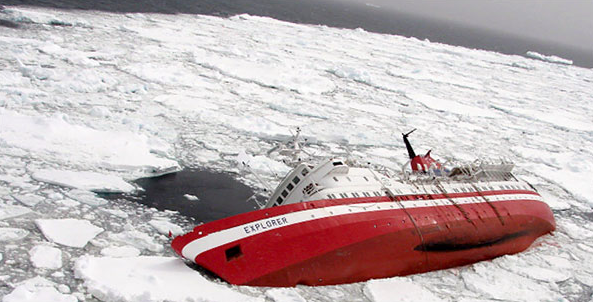On an admittedly slow news weekend, there was something about this photograph that tugged at me.
The picture was front page above fold for a story entitled “An Icy Rescue As Seas Claim A Cruise Ship.” An iceberg punched a hole below the waterline, those aboard spent a few hours in lifeboats before being rescued, and the ship eventually went to the bottom of the Antarctic Ocean.
The story is sappy from start to finish. The Explorer was “fondly known in the maritime world as ‘the little red ship,'” as in The Little Engine that Could, perhaps. It closes with a staffer playing the role of the Old Salt who says, “‘She doesn’t want to give up, I can tell you. I still believe that perhaps it is not the last time that we see her.'” Well, maybe someone will try to salvage a 40-year-old single-hulled craft at the bottom of the world, but don’t bet on it.
If you don’t like the yarn, you won’t like the facts. Although named Explorer, the ship is a cruise ship, carrying “modern adventure travelers” for $7,000-$16,000 a pop. To put it bluntly, those on the ship don’t explore anything. Instead, they go on a set route to have preprogrammed experiences. No wonder they were in such “good spirits”after the rescue: the disaster was a genuine novelty, and one that proved to be just as safe as the trip to Shackleton’s grave. I have no doubt that the episode will be good for business.
Given the reasons to be cynical about this soft news story, why does the image take me down a different path? Perhaps because it looks like one of the toy boats powered by baking soda that I played with in the tub long ago. Or it could be the color: lying on its side on the cold ice flow, it resembles an animal bleeding to death in some lonely winter field. Or the name might matter after all: not just this explorer, but exploration is over, and the challenge now is not discovering some new region but rather living amidst natural scarcity. The ship is disappearing, and so are the ice flows around it. Although they are far more important, no one in the story romanticizes their loss.
Let me add something more to the allegory. Roland Barthes once remarked somewhere that the attraction of a cruise ship, which everyone knows is an antique technology, was that it created the sense of living in an autarky, that is, a self-contained, self-sufficient place. That sense of being a world onto itself is an illusion, of course, one similar to the notion that “modern adventure travelers” are exploring the unknown.
Both myths die hard. If the photo is poignant, it may be because we can imagine not just a ship but a civilization going under. That is, if modern civilization is to avoid disaster, it needs more than a double hull or other technological backups. Instead, we have to give up the idea that we are a law onto ourselves, that we can provide adequately and sustain indefinitely without regard to the natural limits and complex dynamics of the rest of the planet.
Photograph from Fuerza Aerea de Chile [Chilean Air Force] via European Presssphoto Agency.

The photo also reveals the intrusiveness of visuality. These tourists pay a premium to witness the environment in all of its pure and/or threatened glory and in order to satisfy their demanding need to see, they litter the ocean floor with their boat. Much like an accident involving news helicopters or car crashes involving papparazzi, a society’s need to bear witness sometimes becomes so intrusive that we leave the visual remainders of our looking and thereby obscure the thing we wanted to see in the first place.
Actually, the news story isn’t as soft as the teddy-bear reportage proclaims. While the image is pristine and colorful, one of the things that we don’t see is the full tank of fuel that is now on the bottom of the sea filtering up to the surface and poisoning everything in its wake. That’s a nice bonus for the environmentally conscious tourists, I’m sure. And the red and white is a nice contrast with that desolate gray water, so it’s as though the human presence has kind of “enlivened” the place, lucky polar bears! Just like a children’s book — this is an image that has been made for “innocent” eyes while the adults hide the dark truth below the surface.
Quite a picture. My sense is that the picture, unlike some of the others, “opens” response in a particular way: it displays the tension between nature and culture. The striking artificiality of the bright red “Explorer” stands in stark contrast to the broad expanse of “nature” on which it quite literally rests.
What we are to make of this contrast depends o what we bring with us. All of the responses so far make good sense: we bring destruction and danger, we bring a self-contained social order, we bring stories of adventure and exploration, we experience nature or we observe it–but we don’t make it.
Because the contrast is so stark, perhaps the one thing that this photo does not encourage are ways to mediate the difference. Nature is nature, culture is culture. By re-producing this fundamental divide the picture makes it harder to “see” ways in which Antarctica might be a human production, the boat a fact of nature.
Brilliant, and why I read this blog…